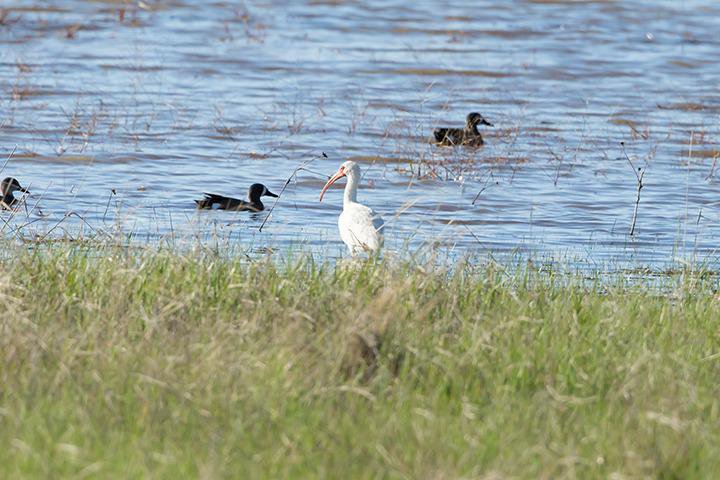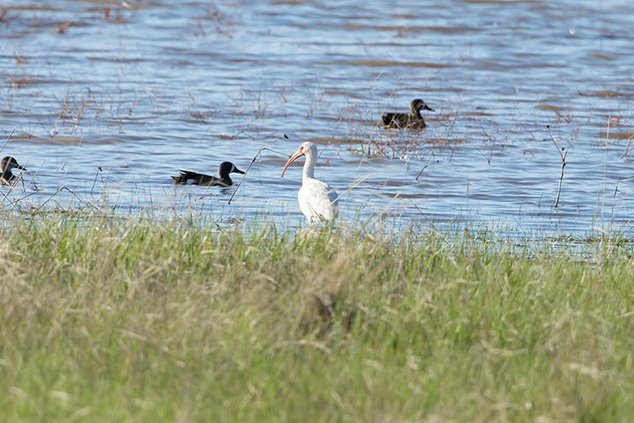The birding community and the Wetlands Center are buzzing with big news about a strange bird at the Bottoms. A White Ibis has appeared for the first time in our memory. It is a shore bird found mostly in the Carolinas down to the south and also in the Caribbean. It does not migrate with the White-faced Ibis which is a purple/brown bird that looks the same except for color and is very plentiful at the Bottoms right now. The White Ibis is hanging with his brothers and sisters in groups along 156 east/north of KWEC. No, I don’t know how long or “if” it will stay. Birders from across the state and beyond have flocked into our area to see this stranger. It is a huge event for serious birders to get a bird like this on their list. We love the visits and company! Curtis Wolf from KWEC discovered the bird. He has a terrific eye and is always looking—he gave me a shout and we got a few pictures.
I have visited with Karl Grover and Charlie Swank at the Bottoms about these unusual visitors. I personally recognize the Snowy Owls that aren’t all that common but do appear with some frequency. There was a Snow Bunting at Quivira a few years ago that caused a stir in the birding community. Karl and Charlie keep meticulous records. A Purple Gallinule showed up in September of 1995. A Gyrfalcon appeared in September of 1996. A Roseate Spoonbill landed here in July of 2003. A Brown Pelican passed through in June of 2014. Rob Penner and Mike Radar probably have others that I don’t know about—they are the soul of serious birding in our area and we are certainly blessed with their knowledge and wisdom.
How do we explain this pheromone? Weather has to be one of the major factors—maybe I should say wind. Cattle Egrets are native to Africa. There were none in the states until the 1980’s. Apparently a huge storm pushed some of those birds into the Caribbean where they took up residence and have populated northward ever since. We see lots of these birds feeding among our cattle herds each year now—they will be here anytime. One of my favorite pictures is a Cattle Egret standing on the head of one of Don Mai’s cows lying on the dam at his pond. It pays to be lucky once in a while.
Karl surmises that occasionally a bird (especially a youngster) gets separated from their group and join the most available gathering which then migrates and the odd bird just travels along. Bad habitat in their preferred area may force them to travel to “greener pastures” where survival is easier. The Whooping Cranes wintering grounds in Texas have lost some of the blue crabs that the birds depend on—everyone is watching to see what they do.
We have a couple of other odd birds in our marsh right now also. Both are geese. One is a White-front and the other is a Snow Goose. I honestly think both of these birds may have been wounded during goose season and survived to good health. Both appear normal to me. They should have migrated north several weeks ago. If one of them happens to produce babies in our marsh it will be another of the “huge” events in the birding community. You can rest assured that Curtis will spot them if it happens!
They beauty and mystery of our marsh expands and changes almost daily now. The night herons are here. The secretive rails and wrens are showing up. There are a few Peregrine Falcons causing havoc. Baby geese are frequently seen. I watched a deer walk across Pool 1 for no obvious reason the other morning. Yellow-headed Blackbirds are sitting by the road. Pheasants are showing off. Egrets are fussing with each other—there is a big “WOW” happening all the time—don’t miss it!
Doc
Marsh Musings
Strangers are Among Us!!!!





